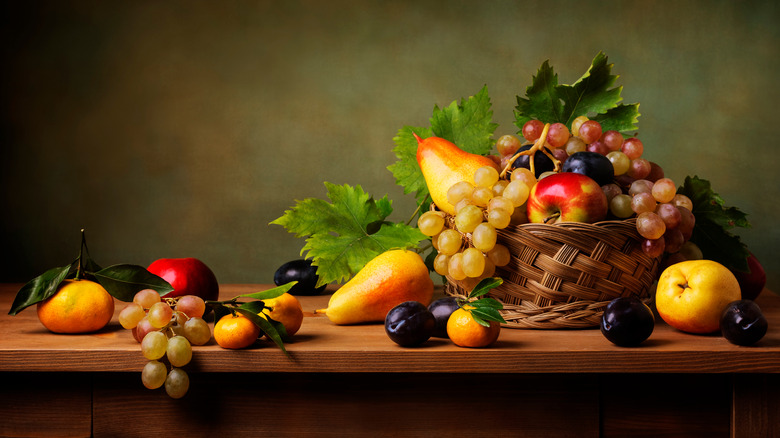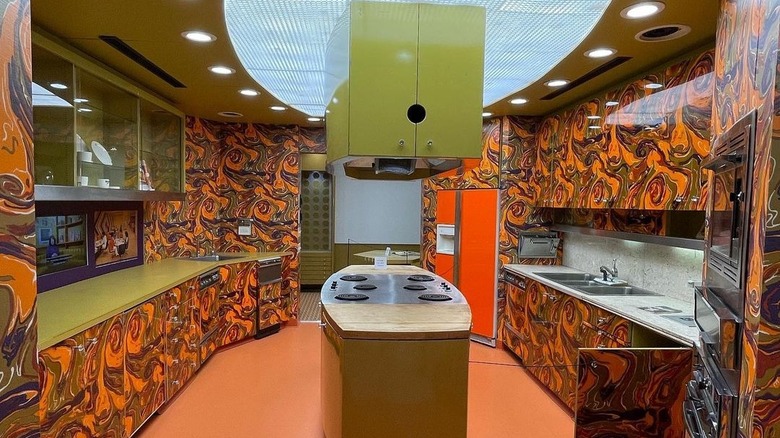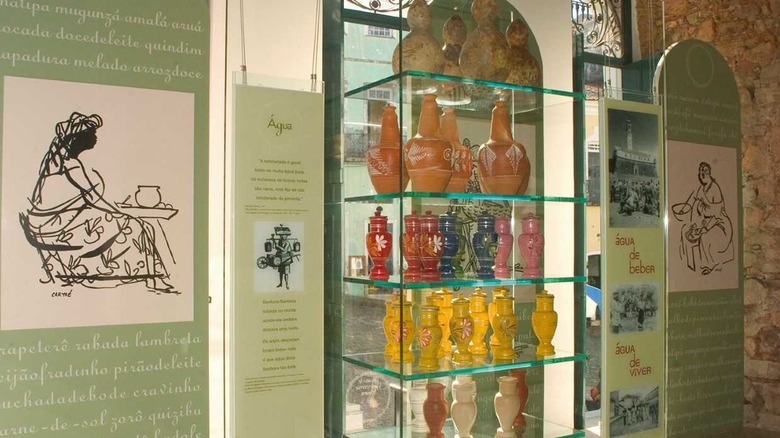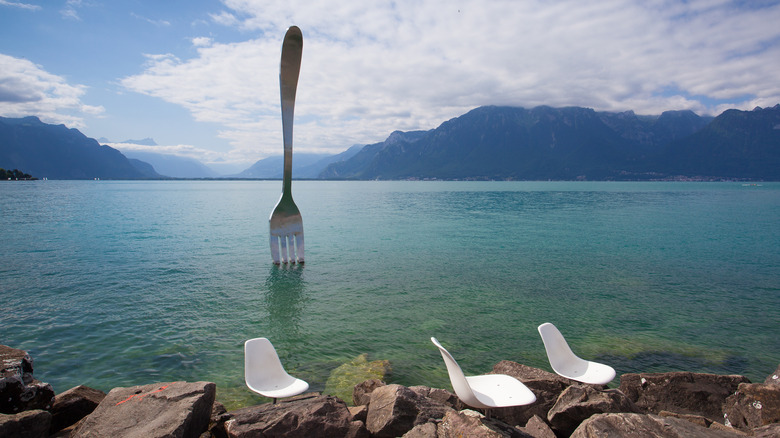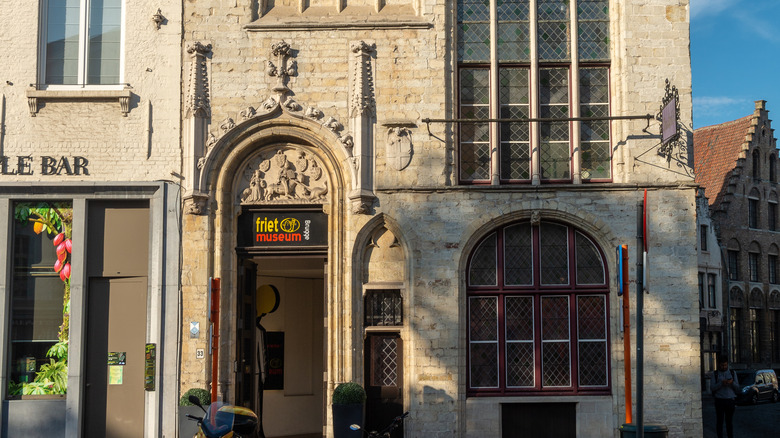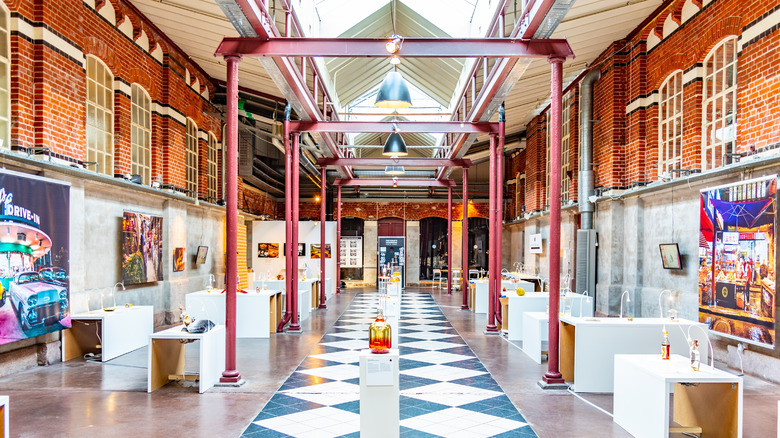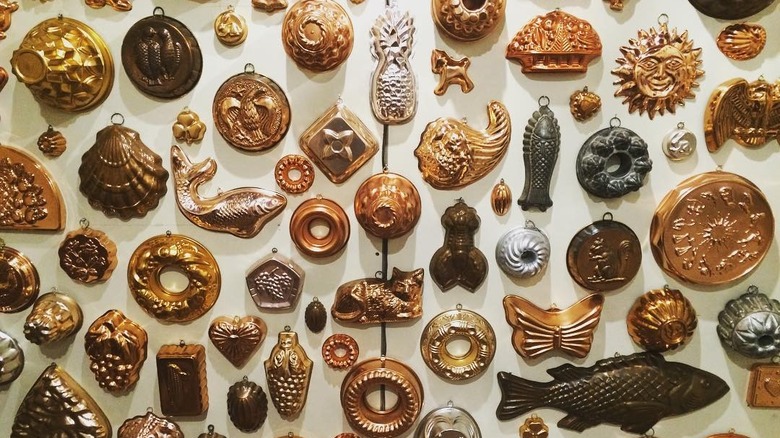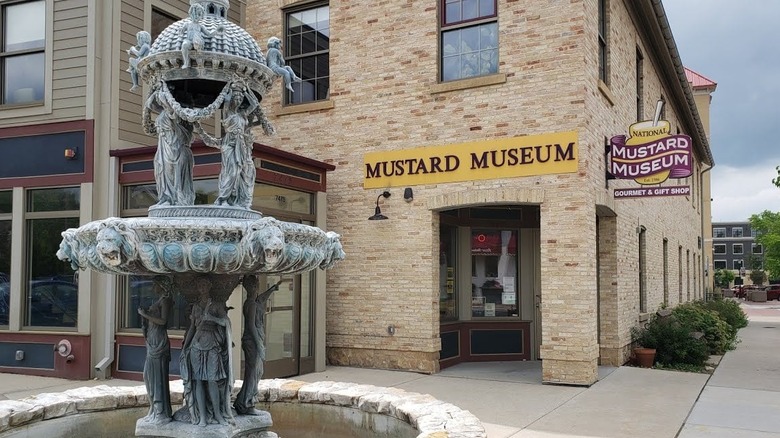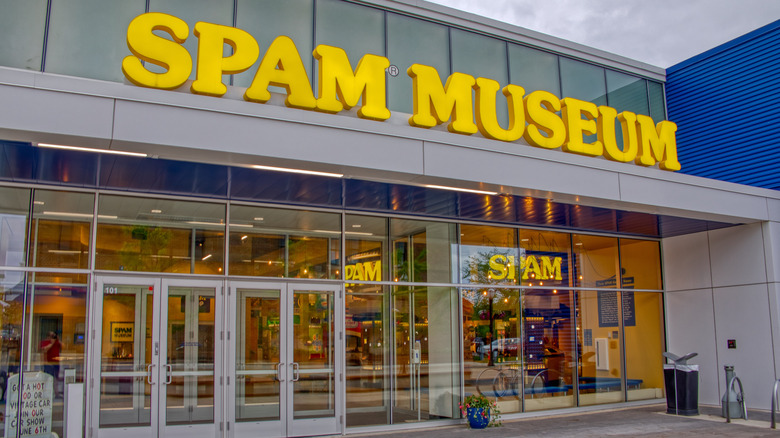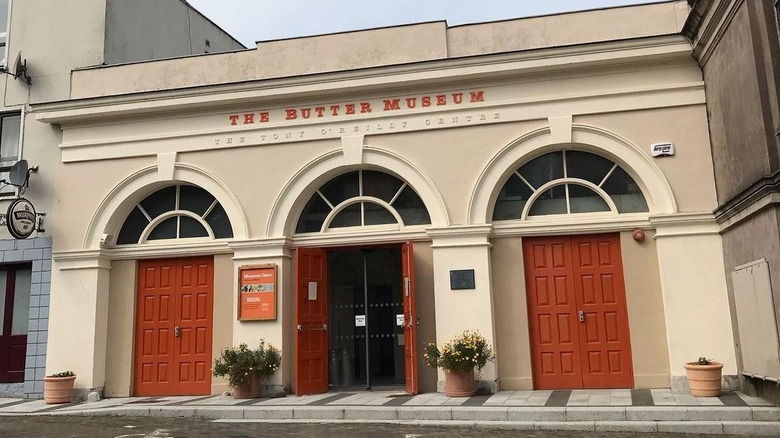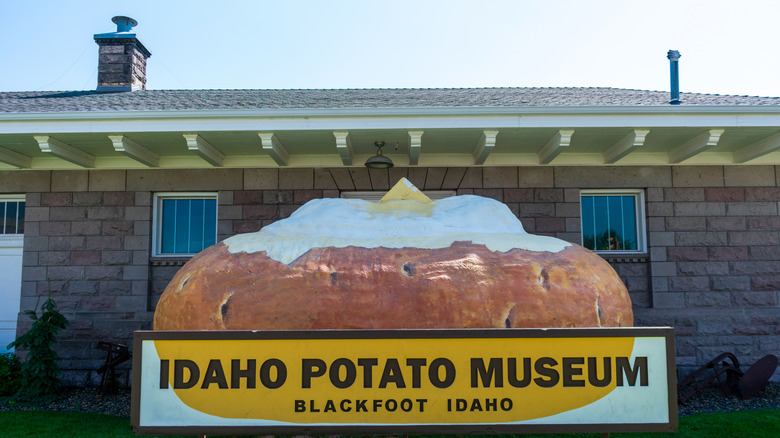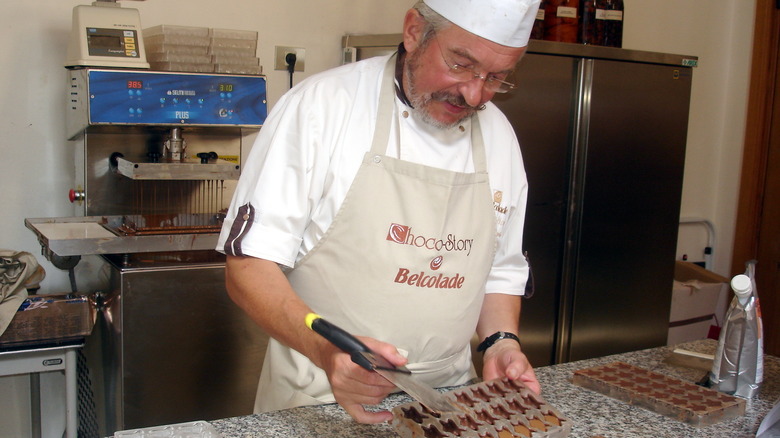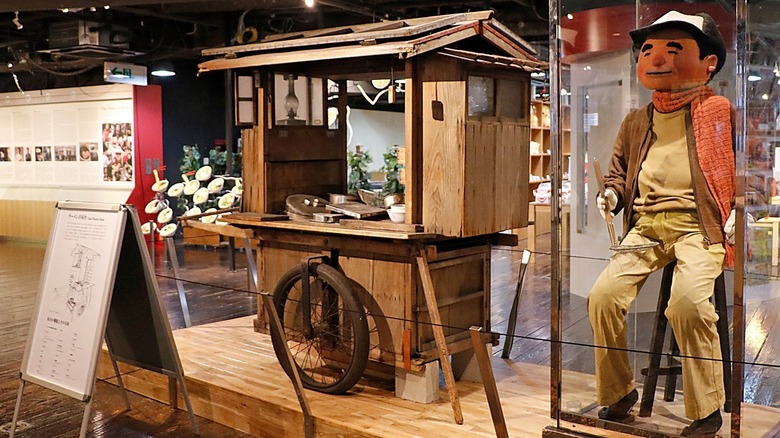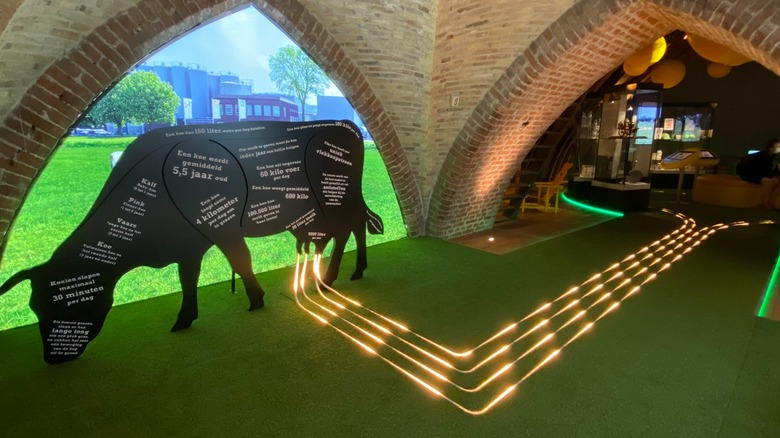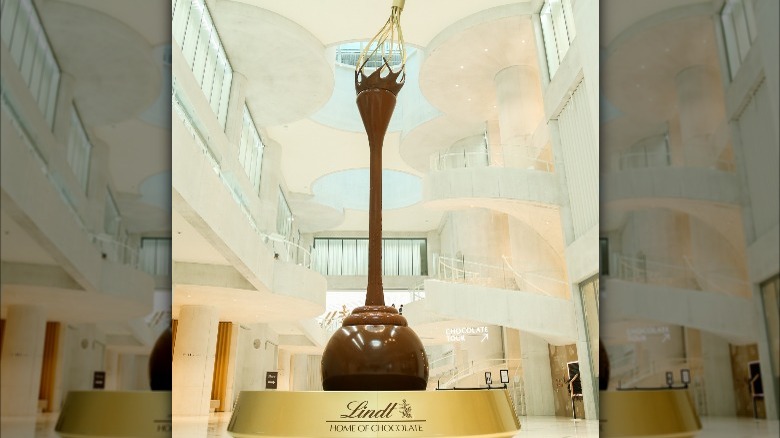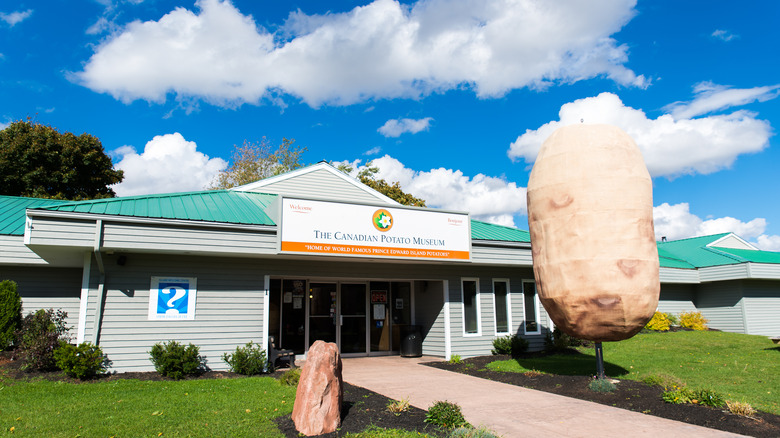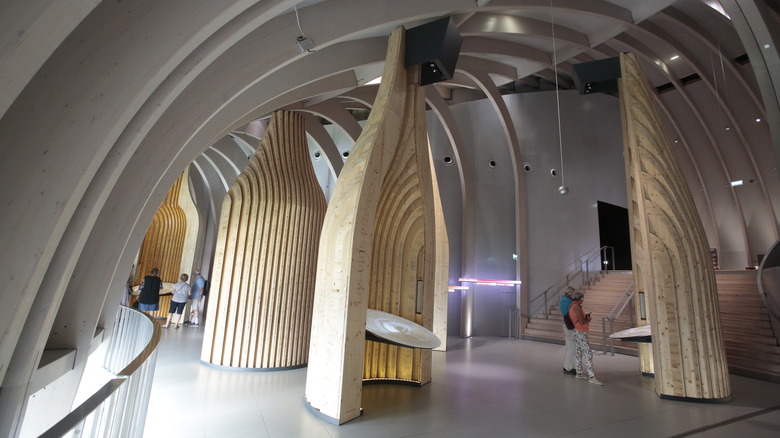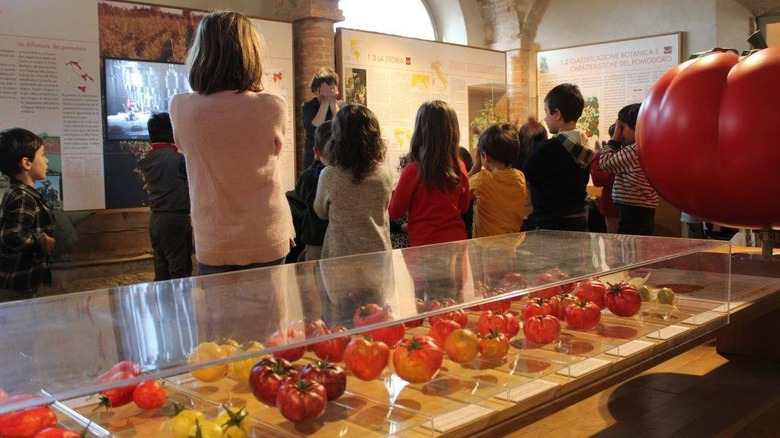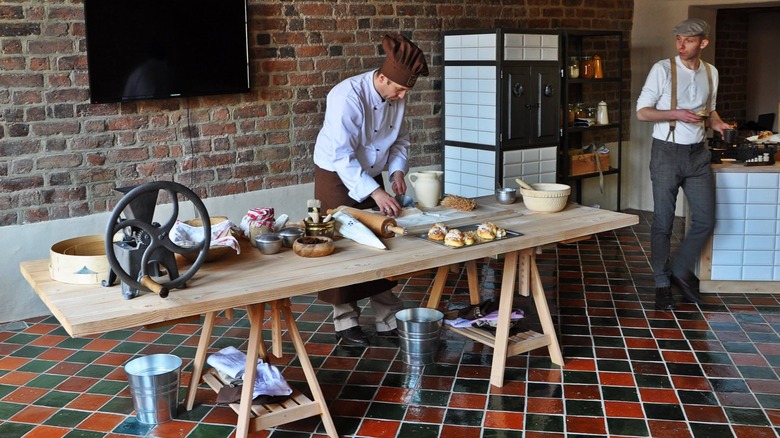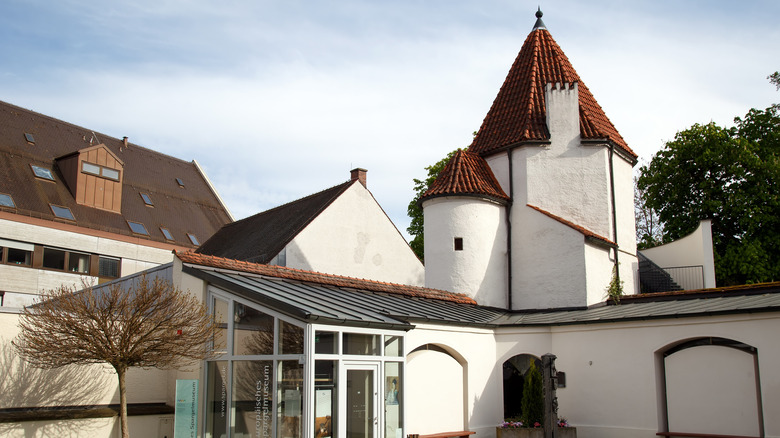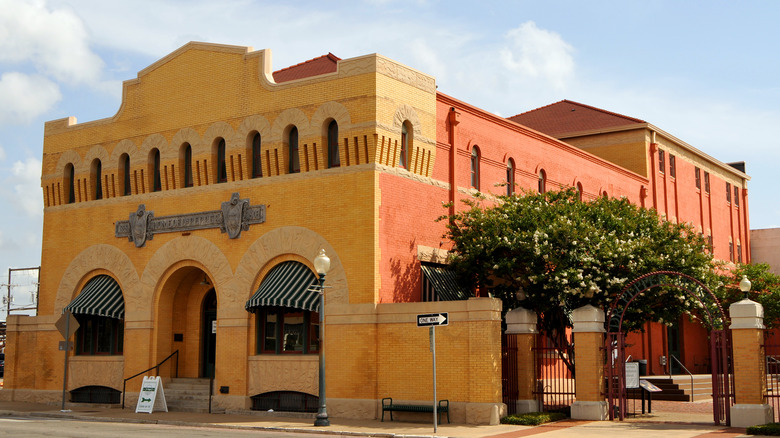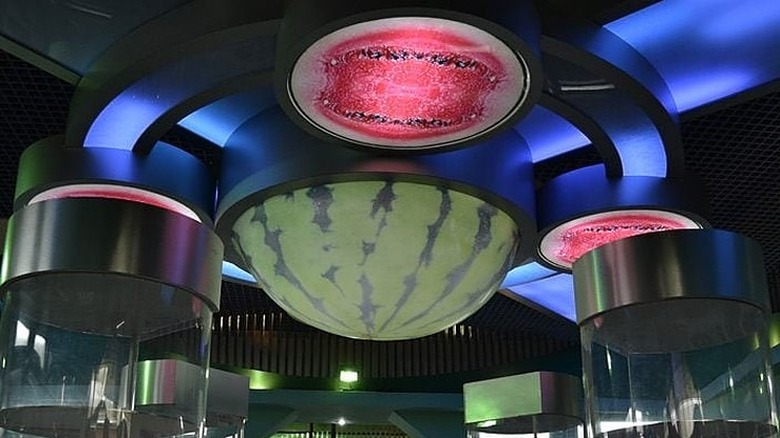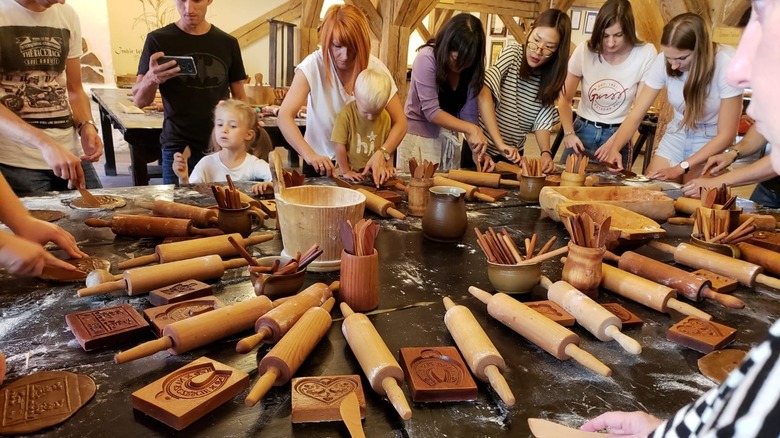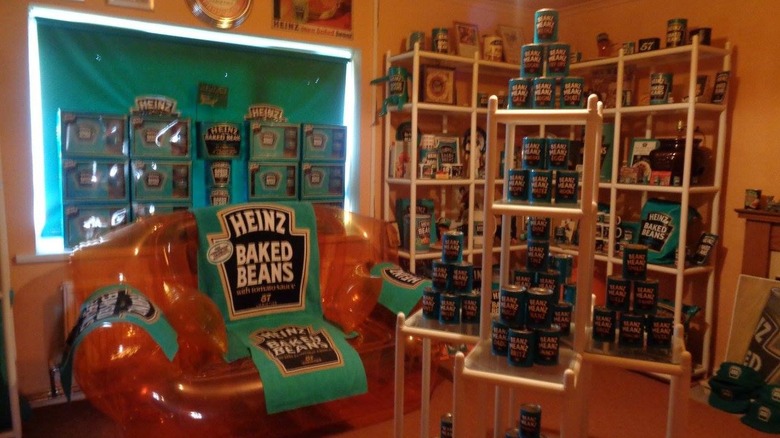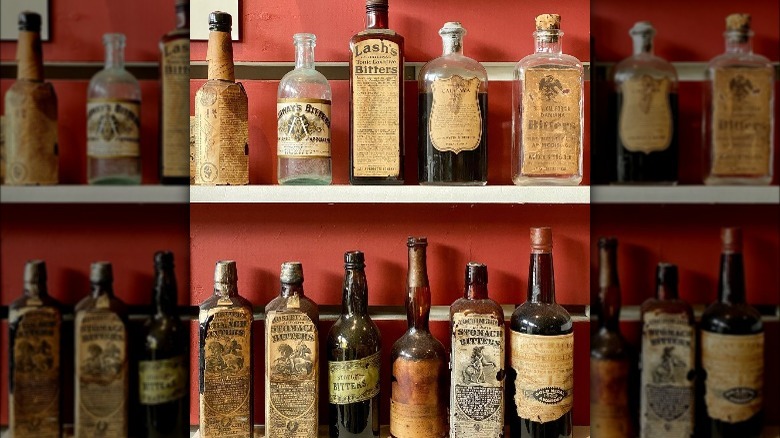Museums Every Food Lover Should Visit At Least Once
There are some foods we love so much that it wouldn't be that far-fetched to build them a shrine. While not as sacred, dozens of museums around the world do essentially that. Whether it's a fry museum in Belgium or a cheese museum in Holland, these foods are significant enough to warrant being showcased. As epicureans, understanding the steps that go into making our favorite foods is part of the joy of eating, and there are some pretty unique processes out there. After all, don't you want to know how they get the center of a Lindt chocolate ball so distinctly rich and smooth?
Whereas some establishments focus on foods that are culturally or regionally symbolic, others, such as The Museum of the American Cocktail, take a broader approach. No matter your food vibe, there's bound to be a museum celebrating something you love. We've collected our top picks of food and drink museums around the world to give you yet another reason to take that trip you've been putting off — until now.
Museum of Food and Drink
It seems fitting that of all the U.S. cities to be the host of the Museum of Food and Drink, New York City would be it. It also makes sense that someone dubbed "the mad scientist of food" by his alma mater (Yale, no less) would be the founder and president of such a spot (via Punch). Starting with Dave Arnold's initial idea to create the museum in 2005, followed by fundraisers and plenty of input from the country's best chefs, the first exhibition in 2013 kicked off the museum's opening with a boom (via MOFAD). Actually, though — it was entitled "BOOM" and was all about the puffing gun used to make a number of types of cereal.
Since its beginning, the museum has remained firmly outside the box, with exhibitions that showcase technologies, issues, and cultural discussions that push boundaries. For example, the "Flavor: Making It and Faking It" exhibit dug deep into the hidden business of manufacturing artificial flavors and was described by MOFAD as a "tasting and smelling adventure." If the thought of reading endless text in a museum bores you, a visit to MOFAD will leave you pleasantly surprised. Among the museum's list of values is the notion that "Food is fun," and that tells you just about everything you need to know about this dynamic spot.
Gastronomy Museum of Bahia
The Gastronomy Museum of Bahia is located in Salvador, the capital city of Brazil's northeastern state Bahia. It's not hard for travelers to come across the building in the heart of Pelourinho, Salvador's historical center. Although it isn't especially large and imposing, this informative museum is run by Senac, an educational organization in Brazil focusing on careers in service, trade, and tourism.
According to Salvador's tourism website, the Gastronomy Museum is intended to educate visitors on the historical, cultural, social, and gastronomical factors that make up the complex world of Bahian food. The museum highlights the influence of Portuguese, African, and indigenous cuisines and ingredients in shaping present-day dishes and culinary traditions. Plus, if you're feeling peckish, you can visit the on-site restaurant run by budding chefs and try the flavors for yourself. If you're looking for a hands-on activity, Lonely Planet reports that the culinary school offers classes for tourists and locals alike.
Alimentarium
Easily identified by the prominent 26-foot stainless steel fork statue in the waters of Lake Geneva, the Alimentarium in Vevey, Switzerland, is a whirlwind of education and fun. And, of course, it's centered around all things food-related. Exhibitions include roundups like "Food — the essence of life" and "#vegan" that investigate all sorts of things. They tie visual and sensory installations into themes regarding health, nutrition, environment, society, and more. The museum's goal is to dig into both past and present elements governing our culinary spheres.
Beyond the permanent and temporary exhibitions, the Alimentarium is a source of activity for both kids and adults. Workshops are regularly offered where you can learn how to whip up Lebanese mezze, cook nutritious meals, or drop off your kids for an instructive and fun experience. Per its website, the Alimentarium has been a leading player in the global food conversation since its opening in 1985. If you can't make it to Switzerland just yet, the museum's online offerings are worthwhile and aim to provide visitors with resources to start exploring various facets of food.
Frietmuseum
It's pretty hard to find someone who doesn't care for fries. Although they're commonly called "French" fries, Belgium has been consistently vying for the title as their country of origin, going so far as to petition it to UNESCO (via BBC). Regardless of the history of hot crispy fries, they're delicious, and the thought of an entire museum dedicated to them is certainly tempting. Located in Bruges, Belgium, the Frietmuseum is the first of its kind.
The interior is filled with assorted items from the history of the fry, from potato crops in the Andes to the countless dipping sauces typically served alongside the salty snack in Belgium. Per Atlas Obscura, guests can observe equipment, artwork, and objects highlighting the preparation of this beloved product. Then, once the temptation has sufficiently built up, make your way to the cellar where you can refuel with some fries and other crunchy bites.
Disgusting Food Museum
It's one thing to visit a museum showcasing your favorite food, but how about the Disgusting Food Museum in Malmö, Sweden? This is undoubtedly a unique concept, though it's worth mentioning that one person's idea of gross food can be a favorite food for another. The reasoning behind the museum's concept is to discover the variability in the notion of disgust and see whether people from different cultures can learn to appreciate foods previously shunned. Aside from expanding our palates, being open to a wider range of food might be an environmentally sustainable way to guide our future consumption.
Among the questionable foods, visitors will find learn more about regional specialties such as cuy (Peruvian roasted guinea pig), hákarl (aged Icelandic shark), and durian (a notoriously stinky fruit from Thailand). Of course, it would be boring if you could only read about these foods, and guests have the opportunity to smell and taste some of them. Be forewarned; the museum's Instagram page shares a running count of the number of guests who have vomited in the process. If you're so inspired that you want to open your own disgusting food exhibit, the museum welcomes partnerships and provides plenty of tips and recommendations to do so.
Jell-O Museum
If you've always been curious about the jiggly, gelatinous Jello-O, then a visit to its birthplace in Le Roy, New York, is in order. The Jell-O Gallery holds a collection of Jell-O related artifacts, including vintage ads, molds in every possible shape, toys, collectibles, and recipes. For a product that's been around for over 100 years, it sure has amassed quite the history. Jell-O is the most well preserved at this unique museum. Although production has since moved to the Kraft factory in Delaware, per the website, it's clear that Le Roy is proud to be the home of Jell-O.
Whether you're curious to know more about the wide range of flavors, the original recipe, or the business side of this sweet treat, all your questions will be answered at the Jell-O Gallery. The museum's Yelp reviews are quite positive, and guests are impressed by the depth of information available at the small location. While it's a fairly niche topic, if you love Jell-O, then you have to find time to visit this quirky spot.
National Mustard Museum
Although mustard isn't the most popular condiment in the U.S., according to a report by Quartz, it's still among the top offerings to smear over a sandwich or hot dog. And the National Mustard Museum in Middleton, Wisconsin, is the place to go if mustard is number one on your list. If a selection of 5,000 plus mustard jars sounds like something you want to see, you've come to the right place. Per the website, what started off as founder Barry Levenson's personal mustard collection soon expanded to include products from over 70 countries, including antiques and historically significant mustards.
From agriculture to fine dining, mustard shows up in many contexts and there's plenty to discover. It's not all theory either; guests can taste from an assortment of mustards both sweet and hot at the Tasting Bar. Of course, you'll be able to buy your favorite styles to take home. According to the website, the mustard museum is on the National Registry of Hysterical Places — who knew mustard was so multifaceted? If you're on the fence about visiting, this fountain of mustard knowledge is totally free to explore!
SPAM Museum
In case you can't make it to Austin, Minnesota, for an in-person tour of the SPAM Museum, fans will be glad to virtually meet SPAMbassadors for a digital tour. However, if your love for this canned meat has brought you to Minnesota, then get ready for a quirky museum experience. For starters, entrance is free but you'll have plenty of opportunities to spend your savings on Spam or branded paraphernalia at the museum gift shop.
The Minnesota tourism website highlights the variety of interactive installations available to visitors, as well as dozens of photo ops waiting for you at the SPAM Museum. Atlas Obscura also describes that a wealth of information regarding the significance of Spam during World War II is on exhibit for guests. While most guests are already firm supporters of the canned meat, museum director Savile Lord tells Roadside America that vegans do make the occasional visit. Whether or not they accept the free samples of Spam is another question.
The Butter Museum
The Butter Museum in Cork, Ireland, is a source of information for all things butter-related. The history of the ubiquitous ingredient and its place throughout the country is showcased, bringing the visitor along for a historical, cultural, and culinary journey. From small-scale to industrial production, butter has evolved in connection with Irish society. While modern consumers might not take note where their butter comes from, Cork was in fact the largest producer worldwide for 150 years, which makes the museum's collection so valuable.
Museum guests can view the transition from agriculture to product, and discover the creation of the Kerrygold butter brand, which is still going strong to this day. Meanwhile, the artistically inclined will admire the selection of butter packaging graphic designs, highlighting the kitchen staple in its progression over time. Unfortunately, Yelp reviewers note that no tastings are offered, but that can be remedied with a quick stop at a local supermarket where you will find a vast selection of Kerrygold goods.
Idaho Potato Museum
Even if you aren't well acquainted with Idaho, chances are you know that the state is one of the leading potato production states in the country (via Agricultural Marketing Resource Center). So it should come as no surprise that Blackfoot, Idaho, boasts its own potato museum. Per the website, the establishment's main goal is to provide visitors with an understanding of the regional spud.
The history depicted at the museum stretches back to the first crops grown in Idaho, up until modern-day factories producing chips. Visitors will have the chance to learn more about the agriculture, harvest, nutrition, and assorted trivia of the trusty tuber (via Idaho Potato Museum). While they might not appear so special, potatoes are responsible for a part of the world's food security, which makes the museum's endeavor to educate its guests so worthwhile. It's not all about facts, and the interactive Potato Lab keeps the visit exciting and fun. And, of course, be sure to stop by the Potato Station Cafe for a selection of treats made with potatoes: cupcakes, ice cream, bread, fries, and salad are listed on the menu.
Choco Story
You probably won't have to twist any arms to convince your travel companions to visit Choco Story in Brussels, Belgium. From its role in Mayan and Aztec cultures to its arrival in Europe, chocolate has always been considered special. Museum guests get to learn all about the steps that go into making the sweet treat, and, more importantly after an actual demonstration of the process, they get to taste it. According to the museum's website, the first pralines were made at the start of the 20th century in Belgium, so it's only right that you make a point to try them at the source!
If you're looking for a more interactive experience, workshops to learn how to make chocolate tablets and pralines are offered. Of course, you'll have extras to take home and savor long after you've left the museum (or maybe not so long). If you're eager to try as many Belgian delicacies as possible, a tasting combining beer and chocolate is also available to museum guests. Honestly, with the various activities, you could very well spend countless hours enjoying yourself at Choco Story.
Ramen Museum
Ramen noodles can be as simple as an instant package or as complex as a piping hot broth brimming with nuanced flavors loaded up with vegetables, meat, and handmade noodles. At the Shin-Yokohama Ramen Museum in Yokohama City (about one hour away from Tokyo), you can discover everything you wanted to know about the flavorful dish. From its origins in China to influences in every corner of Japan, ramen has greatly evolved over time. At the Ramen Museum, you'll actually be able to taste the differences.
When it opened in 1994, the museum's intention was to be the world's first food-themed amusement park, and with close to 10 ramen shops on-site, it fits the description. Among the varieties on offer, visitors can taste the Ryu Shanghai Honten, a rich seafood-based option with spicy miso, or the Rishiri Ramen Miraku, made with a unique type of kelp from Rishiri Island. The latter is notoriously difficult to access as the original restaurant is hard to reach and rarely open, so being able to taste the dish at the Ramen Museum is quite a treat. Apart from endless bowls of ramen to try, the museum also has a section dedicated to the food's history, as well as many opportunities for shopping.
Dutch Cheese Museum
Unless you're lactose intolerant (and maybe even then), cheese is another food that's hard not to like. And while plenty of countries can be applauded for their cheese-making skills, the Dutch do it exceptionally well. At the Dutch Cheese Museum in Alkmaar, Holland, you'll discover countless fun cheese facts, such as that the average Dutchman eats 37 pounds of the stuff per year. The museum's location is specifically chosen as it is right by the Waagplein square — the site of a legendary weekly cheese market from spring to fall, according to the website.
Cheese production in general, and more specifically in Holland, make up a large part of the exhibit, and fun games including a scavenger hunt keep the visit fun for all ages. By the time you leave, you'll know the ins and outs of top Dutch cheeses like gouda and edammer. Buy your favorites and enjoy an impromptu picnic after your visit.
Lindt Home of Chocolate
It's hard not to think about Switzerland when chocolate is mentioned. Lindt is an internationally renowned brand, and its Home of Chocolate is a mandatory stop for chocolate lovers. The museum is located close to Zürich, making it easy to visit if you're in town for a few days. You can either start or end your journey with the chocolate shop, which the website boasts is the largest one in the world at about 5,000 square feet. You're also sure to be wowed by the chocolate fountain, which holds over 3,000 pounds of chocolate, immediately sparking Willy Wonka vibes.
The museum's chocolate tour includes an audio guide for a complete multimedia experience. You'll even get a peek into the chocolate factory production to see all the steps that are undergone to create tablets, balls, and more. Find out what sets Swiss chocolate apart from the rest, and then try it for yourself at the unlimited chocolate tasting! If you're feeling creative, be sure to reserve your place in a chocolate course to make your personal creation. It's easy to have a good time with so many opportunities to eat chocolate.
Canadian Potato Museum
Although Idaho has a firm grip on the U.S. potato market, in Canada, Prince Edward Island (PEI) is the heart of Canada's production (via The Canadian Encyclopedia). The tiny island on the country's east coast claims to hold the largest collection of potato-related farming equipment and artifacts at the Canadian Potato Museum. The obvious first stop is the photo op with the giant potato statue by the entrance.
Inside, you'll learn everything you never knew about the agricultural process behind potato farming. In particular, museum guests will get to see how PEI's one-of-a-kind red soil sets it up for extra delicious spuds (around 100 varieties!). On top of the museum visit, guests can choose to tour an active potato or dairy farm to see it all in action. If you're visiting in the summer months, be sure to grab a bite at the PEI Potato Country Kitchen next door to refuel your energy after this hunger-inducing visit.
La Cité du Vin
If your love for French wine has brought you to the city of Bordeaux, a visit to the Cité du Vin is in order. The imposing structure is overflowing with information about the complex world of wine. The building itself warrants a visit for any fan of architecture, and from the top floor of Belvédère, guests have a 360-degree view of the city. Time your visit right and cap it off with a complimentary glass of wine (included with your purchased ticket) at sunset.
A permanent exhibit provides oenophiles with an in-depth history of wine, spanning millennia. Geography, agriculture, vineyards, winemaking, gastronomy, and plenty more are explored. Per the website, it can easily hold your interest for two to three hours, or you might be so enthralled by the abundance of information and stay the day. Ever-changing temporary exhibitions keep the conversation fresh, and there are various opportunities to stop for a glass of wine. Whether you participate in a tasting workshop or explore the vast collection of bottles (14,000 of them) at Latitude20 (the wine cellar of the world), you'll be pleasantly satisfied.
Parma Food Museums
Italian cuisine easily comes to mind in the vast world of food, and the Food Museums of Parma in Parma, Italy are a testament to the country's vast repertoire of culinary delights. An assortment of museums highlighting important regional products is open to visitors, and there is an emphasis on integrating them into the local preexisting food and wine trails. Plus, the majority of the buildings are historical sites of old markets, factories, and ancient plants.
Thanks to the abundance of products made in the surroundings, the area where the museum is located is referred to as the Parma Food Valley. The variety is impressive, and you'll find dedicated buildings exploring the history, culture, production, and gastronomy of delicacies such as Parma prosciutto, pasta, Parmigiano Reggiano, tomatoes, wine, Culatello di Zibello, Porcini mushrooms, and salami. Sure, these are museums, but dynamic guest interaction is a key factor in the experience. Be ready to touch, taste, and get involved in every gourmet opportunity Parma has to offer (via Musei del Cibo).
Poznan Croissant Museum
Pastries always draw people in, and at the Croissant Museum in Poznan, Poland, visitors can learn all about these flaky treats. The local goods in question are called St. Martin croissants, half-moon pastries loaded with a white poppy seed filling. In fact, according to the town's tourism website, the croissants have a Protected Geographical Indication status and can only be made in the surrounding area following specific guidelines. They've been around for 150 years, so you can bet there's a fair bit of history behind them.
Theory aside, anyone with a sweet tooth will be pleased to know that you'll be able to taste the famed St. Martin croissants. Freshly made by the Croissant Master with the crowd's help, be sure to arrive with an appetite. On top of being the source of decadent croissants, the museum is located in the Old Market Square and has a view of the Town Hall Tower. You'll be getting plenty of culture in your visit as you check out Poznan's top sites.
Asparagus Museum
Asparagus isn't at the top of everyone's list of favorite vegetables, but in Germany, the green spears are a big deal. In fact, Atlas Obscura remarks that here, it is referred to as "the royal vegetable." So it's not really a huge surprise to find the European Asparagus Museum in Schrobenhausen, Germany, the heart of the vegetable's growing area in Bavaria. Aside from being a source for all things asparagus, the building itself is a piece of history, as it was once part of the city's wall and housed a prison.
Asparagus lovers will delight at the curated collection of historical, botanical, and agricultural facts. Meanwhile, relevant art and oddities keep everyone intrigued (there's even a painting of asparagus done by Andy Warhol, according to Atlas Obscura). Per the museum's website, the first-floor exhibit dials in on "eating asparagus," so home chefs might even learn a trick or two for cooking the spring vegetable.
Maine Coast Sardine History Museum
Sardines have long been underrated, but for those people who love the tiny fish, a visit to the Maine Coast Sardine History Museum in Jonesport, Maine is a must. The establishment's intention is to maintain the local sardine industry and spread the word about this regionally significant market. The area was once home to over a dozen canneries, and that history, as well as the entire process, is explored in-depth, according to the museum website.
In case you're not as fond of sardines, you'll be glad to know that Maine's many seafood products are also highlighted in the exhibit. The museum is a labor of love, and the couple behind the installations and resources — Mary and Ronnie Peabody — are united in their vision to preserve any artifacts and history related to Maine's sardine industry. If you share even an inkling of their enthusiasm for sardines, don't miss this charming spot.
Dr Pepper Museum
Unless you're a true fan, you might not know that Dr Pepper is the oldest large-scale producer of soft drinks and syrups in the U.S. The beverage was created in 1885 in Waco, Texas, which is also the location of the Dr Pepper Museum. The building was once a bottling plant, and it is teeming with history in every room. Apart from spreading the love for this sweet beverage, the museum also serves as an educational institute to teach people of all ages about the country's economic structure.
Education is great, but the real fun comes from the various activities the museum offers. Make-A-Soda allows guests to create their own drink using assorted flavor syrups, and Taste-A-Soda sets you up with a selection of soft drinks to try with a Soda Sommelier overseeing the experience. If you drink nothing but Dr Pepper and want a VIP tour, the Extreme Pepper Experience is designed for you. For something informative yet a little more low-key, the Liquid Lab is your best bet. There's even a Paranormal Tour on offer to dig deeper into the history of the museum and building.
Watermelon Museum
You might not have associated watermelons with China, but actually, the largest proportion of global watermelon cultivation takes place here, according to Atlas Obscura. Panggezhuang Town, Beijing is home to the world's only Watermelon Museum, which, according to the city's tourism website, is where some of the best watermelons grow. The building is even designed to resemble the fruit, and it's not hard to see why it goes by the nickname "the flying watermelon."
It's useful to know that there are no English subtitles, so if you're not familiar with Mandarin, either get yourself a translator or let your imagination guide your tour. If you're wondering how watermelons grow, what varieties exist, and anything else regarding their production, then you've come to the right place. We're talking ancient texts, wax replicas, books, and plenty of educational installations. There are even watermelon crops growing on-site, and a summer visit might reward guests with the opportunity to taste some different types (via Atlas Obscura).
The Museum of Toruń Gingerbread
While you might stick to eating gingerbread around the holidays, at The Museum of Toruń Gingerbread in Toruń, Poland, it's a year-round affair. The site of the museum held a gingerbread confectionery known as Kopernik in the late 1800s, so your visit will be informative and historical. According to its website, this is the first interactive museum in Europe which is symbolic in itself (part of the interaction involves baking and eating!).
The stories and legends at the heart of this delightful treat are explored, and the installations highlight its evolution from the Medieval Ages to the current day. From dough ingredients to molds to baking equipment, a thorough overview is provided to educate guests on the entire process. Once they've worked up an appetite, museum visitors have the chance to make and decorate their own gingerbread — and of course — taste! To add to the fun, guests get to use wooden medieval molds, guaranteeing their creations are one-of-a-kind.
The Baked Bean Museum of Excellence
While they might seem like a simple can of sustenance, for some people, baked beans are so much more. Which might explain the existence of The Baked Bean Museum of Excellence in Port Talbot, Wales. According to Atlas Obscura (and perhaps unsurprisingly), this is the only museum with the sole purpose of showcasing baked beans. The man behind it all goes by the name Captain Beany (he legally changed it) and he's no stranger to beans. In fact, per Atlas Obscura, he set a record after spending 100 hours in a bathtub full of baked beans.
Since then, the bean man paints himself in orange and wears a cape. If you get close, you'll see that he has 60 baked beans tattooed on his head. Amidst all these bean-centric accomplishments, it's probably not so wild to think that he opened The Baked Bean Museum of Excellence. The building is actually his own home, so, of course, you'll probably get to meet the famous man. While the artifacts and bean-related paraphernalia are fun and quirky, Captain Beany is probably the most salient reason to visit this museum.
The Museum of the American Cocktail
Anyone can pop open a can of soda and pour it over their favorite spirit, but at The Museum of the American Cocktail (MOTAC) in New Orleans, guests will discover the art of making a perfectly crafted drink. As a part of the National Food & Beverage Foundation, you can bet that the establishment is educational and packed with interesting exhibits. The cocktail museum was founded by one of the earlier leaders in the fine drinks movement, Dale DeGroff, and, along with other experts, he guides amateurs and professionals alike in their quest to learn more.
With memorabilia and plenty of historical facts, MOTAC is your source for anything cocktail-related — except for an actual cocktail that is. Atlas Obscura notes that there is no bar on-site, however, regular mixology workshops and seminars offer participants more learning experiences and some drinks. If you can't make it to New Orleans, a permanent exhibition in Los Angeles is also open.
